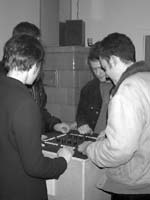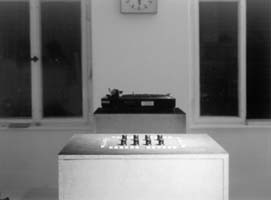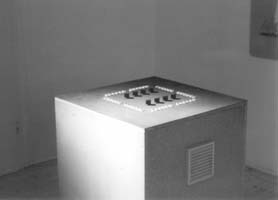
domestic lounge: inv. sys.
involving systems (martin bott/ karl kliem/ sebastian oschatz) ist ein an die arosa 2000 peripherie (frankfurt/main/ ->arosa gardens/ ->elektronik boutique/ ->https://www-cui.darmstadt.gmd.de/arosa/ angelegter entwurf aus robotik, baukunst, klub und taktilität.
zwei äußerlich identische und durch kableschläuche verbundene module sind geometrisch im raum verteilt und bearbeiten musik, die sowohl plattenspieler als auch verborgene gadgets erzeugen. modul 1 stellt den besuchern eine matrix aus drucktastern und drehknöpfen zur verfügung, mit denen einzelne patterns klanglich und rhythmisch selektierbar sind und parametrisch kontrollierbar gehalten werden. modul 2 ist mit einem plattenspieler ausgestattet; hier kann nichtparametrisches material in die komposition einbezogen werden. operiert wird dabei mit einer hinreichend kontingenten plattensammlung (vinyl/hand -> mitbringen). dies alles zwischen djing und testfeld, keine galeriegalerie und überlegter als musikmusik (->produktions/ ->bedingungen/ ->interface). inv.sys. sind manchmal etwas lauter und mit der arosa 2000 cd-rom aus der tasche ein famoser und kolorierender gast.
 |
|
 |
|
 |
|
Mute digital artcritique Summer 1996 Issue 6
INVOLVING SYSTEMS
Interactive Group Sound - Questions and Answers from a technological Wishing Well
Early Spring in Berlin and luxus cont. hosts a performance and mass testing of involving systems. luxus cont. is one of Berlin's current culture/art organisations. It is run by Micz Flor and Martin Conrads who are currently organising a series of events and presentations, domesticated and consumer-friendly packaged in the surfacing privacy of Flor's flat in Mitte. involving systems is many things..... an interactive music making system, it can morph from group entertainment box-set to subtle and sophisticated hybrid-instrument or clunky retro sci-fi prop depending on how and whether people use it.
Roughly described involving systems consists of two hollow plinths, both waist high, which are wired together. One box contains a computer running MAX software (controlling the external devices), a keyboard and samplers. The other an amp and some other devices to control the record deck planted on top of it and to feed signals back to its opposite number in the form of samples which can then be stored. Outside of that, involving systems control mechanisms are deceptively simple: you can place different records on the deck of the one plinth - and scratch and manipulate to your heartâs content - or you can manipulate the stored samples through an arrangement of buttons and dials on top of the first box. The buttons are arranged in a square alongside the top edges of the box. One row calls up drum samples, the one opposite calling up the record samples from the deck. The two others, again opposite each other, call up different synthesiser samples. Each row of buttons includes certain constants: an on/off switch, a range (roughly four) of types of samples, and then (again roughly four) a range of effects which you can apply to the samples. In the middle of this the dials enable intermittent control of pitch etc.
The approach of involving systems is, in some ways, analogous to that of Oval, whose "systemisch" deconstructed both the process, hardware and materials involved in the making of electronic music. Sebastian Oschatz (also part of Oval), Martin Bott and Karl Kliem have, however, elaborated this process by incorporating the infinitely stronger randomising element of group participation. On the one hand, deconstruction here is made as seamless and invisible as possible. This is the user friendly interface pushed to the extreme. Who doesn't know how to push buttons, put a record on or turn dials? Yet involving systems has not been programmed with trigger happy users in mind. It has to be able to function both as interactive sound installation and as sophisticated music generator - capable of being used by one to many players and challenging them with, in Sebastian's words, a steep learning curve.
Many of those visiting luxus cont. were experienced DJ's who managed to find enough variation and instrumental response to interest them for hours! Care has been taken not to fall into the push-and-play quagmire of so many other technologically enhanced interactive play pens. There are however the usual, and universally experienced, problems of interactivity. No matter how sophisticated the set up, a group of individuals all trying out their own compositional ideas isn't usually conducive to the creation of a "whole", no matter how radical your definition of that term may be.
"Resonance of Four", the beautiful sound installation by Toshio Iwai is, in some ways, comparable to involving systems. There visual and aural elements are linked through an illuminated, sensitive grid in which the highlighting of squares determines both rhythm and timbre. In both cases thereâs a kind of initial rush where everybody wants to make patterns, see what the system can do and generally take it apart, after which slow testing and listening starts and a real understanding emerges of the subtleties of the systems possibilities. You could watch people working with involving systems all night, hardly talking, silently waiting to see how their actions wove sounds together. Though the infinite source intimated at is artificial - obsessive preparations went into the storage of appropriate samples - the possibilities aren't. With heavy mood swings coming out of the one really dominant element, the record deck, the flows and eddies of its recombinations become like a sound equivalent of flowing water or flames, variable within limits yet endlessly compelling. The feeling is you are moving towards something. Some conclusion or answer. But it never comes.
Martin Conrads made an analogy which I haven't been able to forget. Watching a small group of people gazing down at the box's top, occasionally pushing a button, waiting, looking at each other. It was like seeing people at a wishing well, looking into it, hoping for answers, guidance, logic. Questioning the technology, using it and letting it use you, involving systems creates an archaic situation where people extend time, wishing and thus creating their own future. Both seem to be experienced as interfaces to a "beyond", more in a temporal than a spatial sense. Just like the well, involving systems' interface is both transparent and opaque, both responsive and mute.
mute magazine, pauline van mourik broekman, london, 06.96.
die tageszeitung
Mai 68 meets technischen Fortschritt
Operateur kann jeder werden: Die Grupppe involving systems hat ein Techno-Soundsystem aufgebaut
Die Eingabeknöpfe könnten genausogut der Steuerung einer der Displays in der Infobox am Potsdamer Platz dienen, die die Kreisläufe von Strom, Wasser und Wärme eines Heizkraftwerkes verdeutlichen. Hier aber sind sie Teil einer Schnittstelle zwischen Techno und Soziologie. Die Gruppe involving systems hat sie entwickelt und im Rahmen von zuhause implementiert, einer Veranstaltung von luxus cont., eigenen Angaben nach noch ein gemeinnütziger Verein in den Archiven des Amtsgerichts Charlotttenburg. Die Präsentation besteht aus zwei Quadern, wovon der eine an den Kanten mit besagten gelben und grünen Druckknöpfen, der andere ebenfalls mit Buttons und einem Plattenspieler ausgestattet ist. Sie scheinen aus einem Paralleluniversum zu stammen, in dem technischer Fortschritt und Mai 68 eine Synthese eingegangen sind, an deren Ende nicht der Walkman als Zeichen für die individuelle Verfügbarkeit von Musik steht. involving systems haben ein Gerät entwickelt, das ein Kommunikationsfeld zwischen Menschen und Maschinen in Form eines stetig vor sich hin blubbernden Acidtracks generiert. Ein Soundsystem zum Eingreifen.
Operateur kann nach einer kurzen Einführung jeder werden: Per Knopfreihe läßt sich die Einspielung der Samples durch den Plattenspieler regeln. Gegenüber können verschiedene Drumpatterns ausgewählt werden. An den beiden verbleibenden Plätzen dienen die Knöpfe der Auswahl von Synthesizersounds und -sequenzen, als Endverstärker dient ein handelsübliches Gerät. Auch wenn der Eindruck vermittelt wird, es handele sich hier um eine Anordnung von consumer electronics, die bloß ausreichend intelligent miteinander verschaltet sind, verbergen die Säulen professionelles Techno-Equipment. Nichtsdestotrotz könnte sie als Laborversuch zur Entwicklung alternativer Endverbrauchertechnologien durchgehen, und tatsächlich ist die Installation ein work in progress, das ständig optimiert wird.
Ausschlaggebend für den entstehenden Sound sind nicht die vorgeschalteten und damit beschränkenden Programmierentscheidungen durch involving systems, sondern die Fähigkeit der Anwender, die Musik während des Spielens miteinander zu planen, um eine größtmögliche Vielfalt beim Kombinieren verschiedener Sounds zu erreichen. Ein frisch eingetroffener DJ wundert sich dann auch für einen Augenblick, was die hier für gute Platten spielen. [...]
die tageszeitung, ulrich gutmair, berlin, 18.04.96.
| * | |
| [invsysmain] | click here to get to the main involving systems content page. |
| [multiplayer] | click here to get to the multiplayer interactive audio installations site. |
| [mesomain] | click here to get to the main meso content page. |
this page is © 1999 invsys frankfurt.
contact invsys at info@involvingsystems.com . fax ++49 69 25495450 . phone ++49 69 25495410